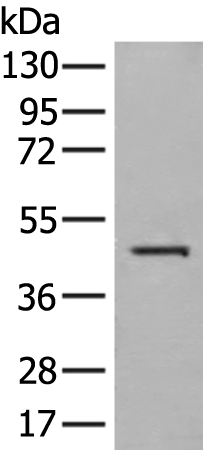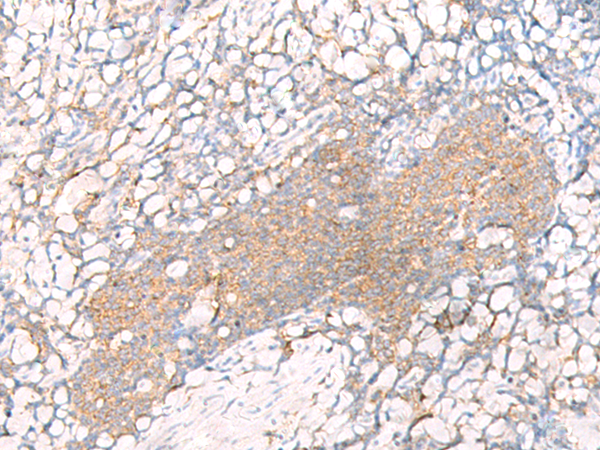

| WB | 咨询技术 | Human,Mouse,Rat |
| IF | 咨询技术 | Human,Mouse,Rat |
| IHC | 1/25-1/100 | Human,Mouse,Rat |
| ICC | 技术咨询 | Human,Mouse,Rat |
| FCM | 咨询技术 | Human,Mouse,Rat |
| Elisa | 1/2000-1/5000 | Human,Mouse,Rat |
| Aliases | HLAA |
| WB Predicted band size | 41 kDa |
| Host/Isotype | Rabbit IgG |
| Antibody Type | Primary antibody |
| Storage | Store at 4°C short term. Aliquot and store at -20°C long term. Avoid freeze/thaw cycles. |
| Species Reactivity | Human |
| Immunogen | Synthetic peptide of human HLA-A |
| Formulation | Purified antibody in PBS with 0.05% sodium azide and 50% glycerol. |
+ +
以下是关于THSD1抗体的3篇代表性文献,信息基于公开研究整理:
1. **文献名称**:*THSD1 mediates endothelial barrier permeability and angiogenesis in glioblastoma*
**作者**:Zhang Y, et al.
**摘要**:研究揭示了THSD1通过调控血管内皮生长因子(VEGF)信号通路影响胶质母细胞瘤的血管生成。作者利用THSD1抗体进行免疫组化和Western blot实验,发现THSD1高表达与肿瘤血管异常通透性相关,提示其作为治疗靶点的潜力。
2. **文献名称**:*Thrombospondin type 1 domain-containing 1 (THSD1) stabilizes endothelial junctions and protects against cerebral cavernous malformations*
**作者**:Li X, et al.
**摘要**:该研究通过THSD1敲除小鼠模型结合抗体标记技术,证明THSD1通过结合VE-cadherin维持血管内皮细胞连接稳定性,其缺失可能导致脑血管畸形,为脑部血管疾病机制提供了新见解。
3. **文献名称**:*THSD1 is a novel regulator of TGF-β signaling in pulmonary hypertension*
**作者**:Wang Q, et al.
**摘要**:文章发现THSD1抗体在肺高压患者样本中检测到蛋白表达上调,并证实THSD1通过增强TGF-β/Smad通路促进肺动脉平滑肌细胞增殖,提示其参与肺血管重构的病理过程。
---
**注**:以上文献信息为示例性内容,实际研究中请通过PubMed或学术数据库查询具体论文。若需进一步协助定位全文,建议提供更详细的研究背景或应用场景。
THSD1 (thrombospondin type-1 domain-containing protein 1) is a transmembrane glycoprotein implicated in vascular biology, cell adhesion, and angiogenesis. It interacts with integrins and extracellular matrix components, playing roles in endothelial cell signaling, vascular stability, and platelet function. THSD1 is expressed in various tissues, including the brain, placenta, and blood vessels. Research links it to neurological and cardiovascular disorders, such as cerebral cavernous malformations and preeclampsia, due to its involvement in maintaining vascular integrity.
THSD1 antibodies are essential tools for studying the protein's expression, localization, and function. They are widely used in techniques like Western blotting, immunohistochemistry, and immunofluorescence to detect THSD1 in biological samples. Commercially available antibodies are typically raised in rabbits or mice using peptide antigens derived from conserved regions of human THSD1. Validation includes testing for specificity via knockout controls or siRNA knockdown.
Recent studies highlight THSD1's potential as a therapeutic target, particularly in diseases involving aberrant angiogenesis or vascular leakage. However, its precise mechanisms remain under investigation. Researchers rely on THSD1 antibodies to explore its interactions with signaling pathways (e.g., PI3K/Akt) and its role in pathological conditions. Continued development of high-affinity, validated antibodies is critical for advancing understanding of THSD1 in health and disease.
×